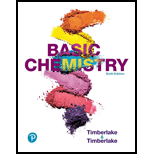
(a)
Interpretation:
The chemical formula of calcium carbonate is to be stated.
Concept Introduction :
A chemical formula of a given compound is used to describe the number of atoms present in it. Since a compound is made of two or more than two different elements in definite proportion, a chemical formula can best describe the number of elements it contains with their atomic symbols.
(b)
Interpretation:
The chemical formula of carbon dioxide is to be stated.
Concept Introduction :
A chemical formula of a given compound is used to describe the number of atoms present in it. Since a compound is made of two or more than two different elements in definite proportion, a chemical formula can best describe the number of elements it contains with their atomic symbols.
(c)
Interpretation:
The chemical formula of iron(II) sulfate is to be stated.
Concept Introduction :
A chemical formula of a given compound is used to describe the number of atoms present in it. Since a compound is made of two or more than two different elements in definite proportion, a chemical formula can best describe the number of elements it contain with their atomic symbols.
Want to see the full answer?
Check out a sample textbook solution
Chapter 6 Solutions
Pearson eText Basic Chemistry -- Instant Access (Pearson+)
- 68. Write the formula for each of the following compounds: a. chromium(III) hydroxide b. magnesium cyanide c. lead(IV) carbonate d. ammonium acetatearrow_forwardWrite the formula for each of the following polyatomicions:a. the sulfate ion b. the nitrate ionarrow_forwardWrite the formula for each of the following polyatomicions:a. the phosphate ion b. the cyanide ionarrow_forward
- 10. Chemical substance commonly used as a flavor enhancer: A. Monosodium glutamate (MSG) C. tocopherol B. Vitamin C D. lecithin 11. Which of the following chemical substance increase the volume of food through the presence of carbon dioxide (gas)? A. Monosodium glutamate (MSG) C. sodium bicarbonate B. Nitrates D. lecithin 12. Which of the groups mentioned below are non-caloric sweeteners? A. Honey, sorbitol, fructose B. Aspartame, saccharin, sucralose C. aspartame, glucose, sucralose D. Honey, sorbitol, glucosearrow_forward1. Write the formula of the following compounds: a. Strontium Hydride b. Radium peroxide c. Cesium superoxidearrow_forwardOGive the formula of the following compounds: a. Cobalt(III) sulfite b. triphosphorus pentoxide c. calcium selenidearrow_forward
- . Write a chemical formula for each of the following compounds: ( a. lithium sulfate b. cobalt (II) chlorate c. aluminum acetate d. sodium perphosphate e. lead (II) phosphitearrow_forwardWrite the chemical formula of the following. A. Calcium chloride B. Calcium chloratearrow_forward10. The element X in a compound was involved in a chemical reaction. After the reaction was completed, which of these would likely happen to the mass of element X? a. It will increase b. It will disappear c.It will be doubled d. It will remain the samearrow_forward
- 23. Write formulas and names for compounds formed from the following metal ions and polyatomic ions. a. Calcium ion and the sulfate ion b. The copper (I) ion and phosphate ion c. The sodium ion and the carbonate ion d. The ammonium ion and the nitrate ionarrow_forwardWrite the formula including the charge for each of the following polyatomic ions:a. hydrogen carbonate(bicarbonate) b. ammoniumc. phosphite d. chloratearrow_forwardThe chemical name for laughing gas, which can be used as an anesthetic, is dinitrogen monoxide. The chemical formula for laughing gas is Group of answer choices A. N2O. B. NO. C. ON2. D. NO2.arrow_forward
- Chemistry: Matter and ChangeChemistryISBN:9780078746376Author:Dinah Zike, Laurel Dingrando, Nicholas Hainen, Cheryl WistromPublisher:Glencoe/McGraw-Hill School Pub Co
 Introductory Chemistry: A FoundationChemistryISBN:9781337399425Author:Steven S. Zumdahl, Donald J. DeCostePublisher:Cengage Learning
Introductory Chemistry: A FoundationChemistryISBN:9781337399425Author:Steven S. Zumdahl, Donald J. DeCostePublisher:Cengage Learning

